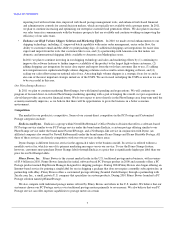Stamps.com 2010 Annual Report Download - page 21
Download and view the complete annual report
Please find page 21 of the 2010 Stamps.com annual report below. You can navigate through the pages in the report by either clicking on the pages listed below, or by using the keyword search tool below to find specific information within the annual report.
TABLE OF CONTENTS
If we do not respond effectively to technological change, our services and products could become obsolete and our
business will suffer.
The development of our services, products and other technology entails significant technical and business risks. To remain
competitive, we must continue to enhance and improve the responsiveness, functionality and features of our online operations.
The Internet and the electronic commerce industry are characterized by rapid technological change, changes in user and
customer requirements and preferences, frequent new product and service introductions embodying new technologies, and the
emergence of new industry standards and practices.
The evolving nature of the Internet or the postage markets could render our existing technology and systems obsolete. Our
success will depend, in part, on our ability to (i) license or acquire leading technologies useful in our business, (ii) enhance our
existing services, (iii) develop new services or features and technology that address the increasingly sophisticated and varied
needs of our current and prospective users, and (iv) respond to technological advances and emerging industry and regulatory
standards and practices in a cost-effective and timely manner.
Future advances in technology may not be beneficial to, or compatible with, our business. Furthermore, we may not be
successful in using new technologies effectively or adapting our technology and systems to user requirements or emerging
industry standards on a timely basis. Our ability to remain technologically competitive may require substantial expenditures and
lead time. If we are unable to adapt in a timely manner to changing market conditions or user requirements, our business,
financial condition and results of operations could be seriously harmed.
Our operating results could be impaired if we or the Internet become subject to additional government regulation.
Changes in the laws and regulations applicable to the Internet or us, including those relating to user privacy, pricing, content,
copyrights, distribution, characteristics and quality of products and services, and export controls, could seriously harm our
business, financial condition and results of operations. Moreover, the applicability of existing laws to the Internet is uncertain
with regard to many issues, including property ownership, export of specialized technology, sales tax, libel and personal privacy,
and changes in their interpretation could similarly harm us. The application of laws and regulations from jurisdictions whose
laws do not currently apply to our business, or the application of existing laws and regulations to the Internet and other online
services could also harm our business.
We have employees and offer our services in multiple states, and we may in the future expand internationally. These
jurisdictions may claim that we are required to qualify to do business as a foreign corporation in each state or foreign country.
Our failure to qualify as a foreign corporation in a jurisdiction where we are required to do so could subject us to taxes and
penalties. Other states and foreign countries may also attempt to regulate our services or prosecute us for violations of their laws.
Risks Related to Our Stock
The tax value of our net operating losses could be impaired if we trigger a change of control pursuant to Section 382 of
the Internal Revenue Code.
We currently have federal and state net operating loss (“NOL”) carry-forwards of approximately $226 million and $148
million, respectively, which when combined with our other tax credits and tax assets has a potential value of up to $94 million in
tax savings over the next 15 years. Under Internal Revenue Code Section 382 rules, if a “change of ownership” is triggered, our
NOL asset may be impaired. A change in ownership can occur whenever there is a shift in ownership by more than 50
percentage points by one or more “5% shareholders” within a three-year period. We estimate that as of December 31, 2010 we
were at approximately a 22% level compared with the 50% level that would trigger impairment of our NOL asset.
Under our certificate of incorporation, any person or entity, including company or investment firm, that wishes to become a
“5% shareholder” (as defined in our certificate of incorporation) must first obtain a waiver from our board of directors. In
addition any person or entity, including any company or investment
17
























